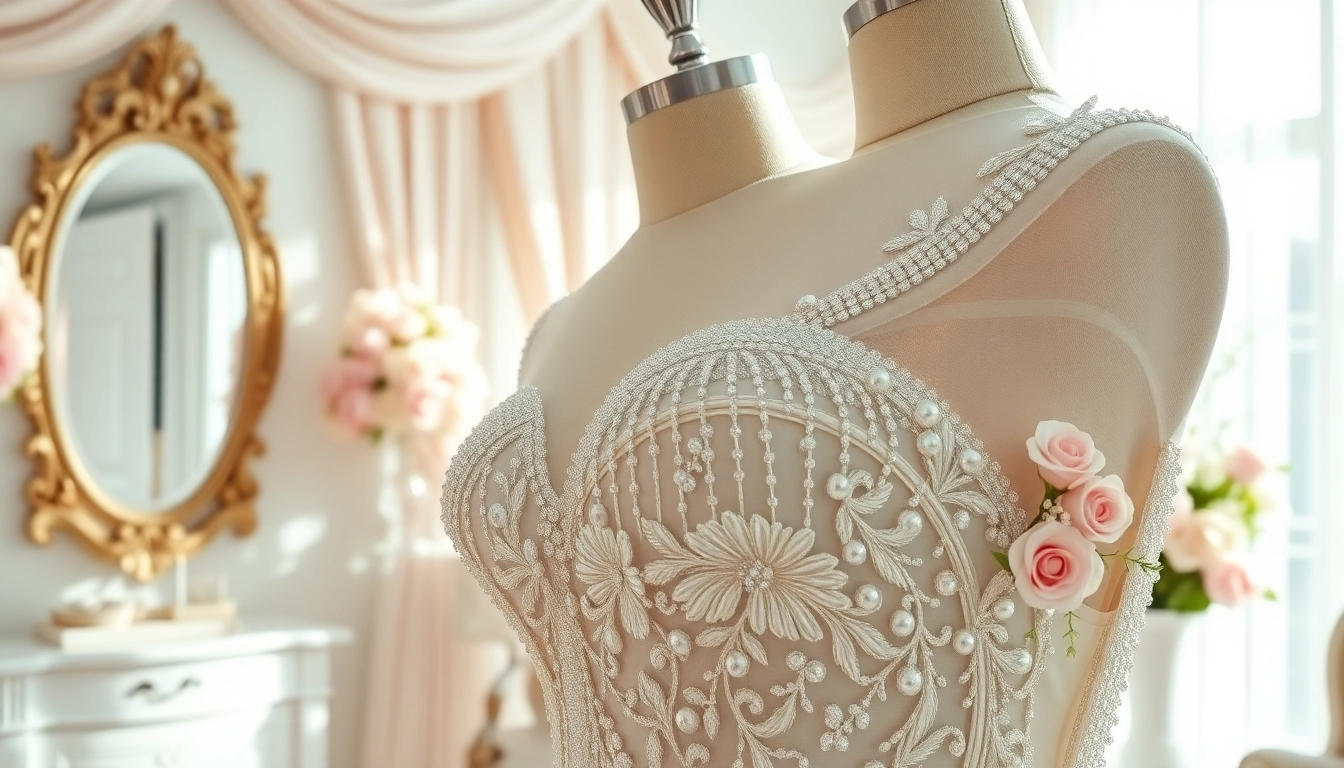Understanding Lace Wedding Dresses
Lace wedding dresses have captivated brides with their intricate designs and romantic allure for decades. The texture and pattern of lace add depth and elegance to any gown, making it a popular choice for bridal wear. From vintage styles to contemporary silhouettes, Lace Wedding Dresses offer an array of options that cater to various tastes and personalities. In this article, we will delve into the definition and types of lace wedding dresses, explore their benefits, and examine the different styles and silhouettes that brides can choose from.
Definition and Types of Lace Wedding Dresses
The term ‘lace’ refers to a delicate fabric designed using a web-like pattern of threads. Traditionally made from threads of cotton, silk, or synthetic fibers, lace is characterized by its openness and complexity of design. In the realm of bridal fashion, lace wedding dresses come in numerous types, including:
- Chantilly Lace: Known for its intricate floral patterns and lightweight feel, Chantilly lace is often used for overlays and accents.
- Alençon Lace: This heavier lace features a raised design and is often used to create a more classic and formal wedding dress.
- Guipure Lace: Distinct for its embroidered motifs connected by bars or a net background, guipure lace provides a bold structure that’s perfect for more modern designs.
- Bobbin Lace: With a unique handmade quality, bobbin lace entails twisting and braiding threads, producing intricate designs perfect for vintage-inspired gowns.
Benefits of Choosing Lace Wedding Dresses
Choosing lace wedding dresses comes with an array of advantages that enhance the overall bridal experience. Some of these benefits include:
- Timeless Elegance: Lace is synonymous with classic bridal aesthetics. Its delicate patterns evoke a sense of romance and sophistication perfect for any wedding theme.
- Versatile Styles: Lace can easily complement a variety of styles—from bohemian to vintage to modern. This versatility allows brides to express their individuality while maintaining elegance.
- Romantic Appeal: Lace adds texture and depth, creating an ethereal look that many brides desire on their special day. The intricate patterns often symbolize love and tradition.
Different Styles and Silhouettes
Lace wedding dresses are available in a multitude of styles and silhouettes, each offering a unique flair. Here are some popular options:
- A-Line: A universally flattering silhouette that flares gently from the waist down, the A-line lace wedding dress is suitable for all body types.
- Mermaid: This fitted silhouette hugs the body and flares out at the knees, creating a dramatic hourglass shape that is excellent for highlighting curves.
- Ball Gown: The classic ball gown silhouette features a fitted bodice and a voluminous skirt, perfect for brides wishing to embody a fairytale look.
- Sheath: This sleek silhouette runs straight from the neckline to the hem, emphasizing the bride’s natural shape and creating an understated elegance.
- Bohemian: Characterized by flowing fabrics and relaxed lines, bohemian lace wedding dresses often incorporate elements such as fringe, fringe overlays, and earthy motifs.
The History of Lace in Bridal Fashion
Lace has a rich history that dates back to the 15th century, intricately woven into the fabric of European fashion, especially in bridal couture. Understanding the evolution of lace in wedding dresses reveals how this delicate fabric has transformed over the centuries.
Traditional Lace Patterns and Techniques
Historically, lace was a sign of wealth and status. Techniques utilized in the creation of lace included needle lace, bobbin lace, and cutwork, with intricate patterns being painstakingly crafted by skilled artisans. The use of lace in bridal fashion signified luxury and elegance, making it a sought-after material for high-profile weddings.
The Evolution of Lace Wedding Dresses
Throughout the years, lace wedding dresses have adapted to reflect shifting fashion trends. In the early 20th century, lace began to adorn wedding gowns more prominently, symbolizing purity and femininity. The 1920s introduced flapper-style lace dresses, while the 1950s showcased fuller skirts combined with lace fabrics. Today, contemporary designers experiment with lace through unexpected textures, patterns, and innovative constructions.
Contemporary Innovations in Lace Designs
Modern innovations continue to push the boundaries of lace wedding dresses. Designers today employ technology to create hybrid fabrics, fusing lace with materials like tulle, chiffon, and crepe to enhance functionality and style. New printing techniques also allow for patterns and colors that were previously unimaginable with traditional lace, making it an even more exciting choice for today’s brides.
Choosing the Perfect Lace Wedding Dress
Finding the perfect lace wedding dress is a crucial part of the bridal journey. With so many styles, patterns, and details, it is essential to navigate the selection process with care.
Factors to Consider When Selecting Lace Wedding Dresses
When choosing lace wedding dresses, brides should consider factors like:
- Wedding Theme: The style of lace should align with the overall wedding theme—whether it’s rustic, romantic, or glam.
- Location: An outdoor beach wedding may call for lighter fabrics, while an indoor formal ceremony might benefit from richer, layered lace.
- Season: Heavier laces may be more appropriate for colder months, while lighter lace designs are ideally suited for spring and summer ceremonies.
Body Types and Appropriate Lace Styles
Understanding how different lace styles flatter various body types is crucial in selecting a dress that will enhance the bride’s features:
- Hourglass: Fitted mermaid or sheath styles showcase curves beautifully, emphasizing the waist.
- Pear Shape: A-line dresses with delicate lace details help balance broader hips.
- Apple Shape: Empire waist or ball gown styles with breathable lace can create a refined silhouette.
- Straight/Rectangle: Any style that adds volume, such as a ball gown with a lace overlay, can create curves.
Color Variations in Lace Wedding Dresses
While traditional white and ivory lace wedding dresses remain popular, contemporary brides have explored color variations. Dresses can feature colored lace patterns or subtle stitching that adds a whimsical touch. Popular colors include blush, champagne, and even pastel tones that complement various wedding palettes.
Caring for Your Lace Wedding Dress
Proper care is essential to ensure that lace wedding dresses retain their beauty long after the wedding day. From cleaning to storage, each step plays a significant role in the longevity of the dress.
Cleaning and Maintenance of Lace Fabrics
Due to lace’s delicate nature, professional cleaning is recommended. It’s essential to avoid any harsh chemicals that could damage the fabric. If simple spot cleaning is needed, always test a small area first to ensure that no discoloration occurs.
Storage Tips for Lace Wedding Dresses
To retain the integrity of a lace wedding dress:
- Choose the Right Storage: Store the dress in a cool, dry place, away from direct sunlight that could cause fading.
- Use Acid-Free Materials: When storing, opt for acid-free tissue and a breathable garment bag to maintain the dress’s shape and prevent yellowing.
Repairing and Altering Lace Dresses
Over time, wear and tear may require repairs. Seeking professional seamstress services ensures that any alterations or repairs are handled delicately, preserving the lace’s intricate beauty while ensuring a perfect fit.
Accessorizing Lace Wedding Dresses
The right accessories can elevate lace wedding dresses, weaving in personal style while enhancing the overall look.
Jewelry Choices for Lace Wedding Dresses
Selecting jewelry that complements lace can be understated yet elegant. For instance:
- Delicate Earrings: Simple stud earrings or small drop earrings help highlight but not overpower the lace.
- Necklaces: A subtle pendant may work well with square or boat necks, while statement pieces should be reserved for less intricate lace designs.
Complementary Veils and Headpieces
Veils can beautifully enhance lace wedding dresses. Options like:
- Cathedral Veils: Traditionally layered and long, cathedral veils create an elegant statement especially with intricate lace detailing.
- Birdcage Veils: These vintage-inspired options offer a charming contrast to flowy lace designs.
- Floral Crowns: A bohemian twist that pairs well with lightly embellished lace dresses.
Footwear That Complements Lace Wedding Dresses
Choosing bridal shoes is an important aspect of the complete ensemble. Some considerations include:
- Style: Strappy sandals enhance the romantic vibe of lace dresses, while embellished pumps add glam.
- Comfort: Given the long hours of wear, comfort is paramount, so find shoes that balance style with practicality.


